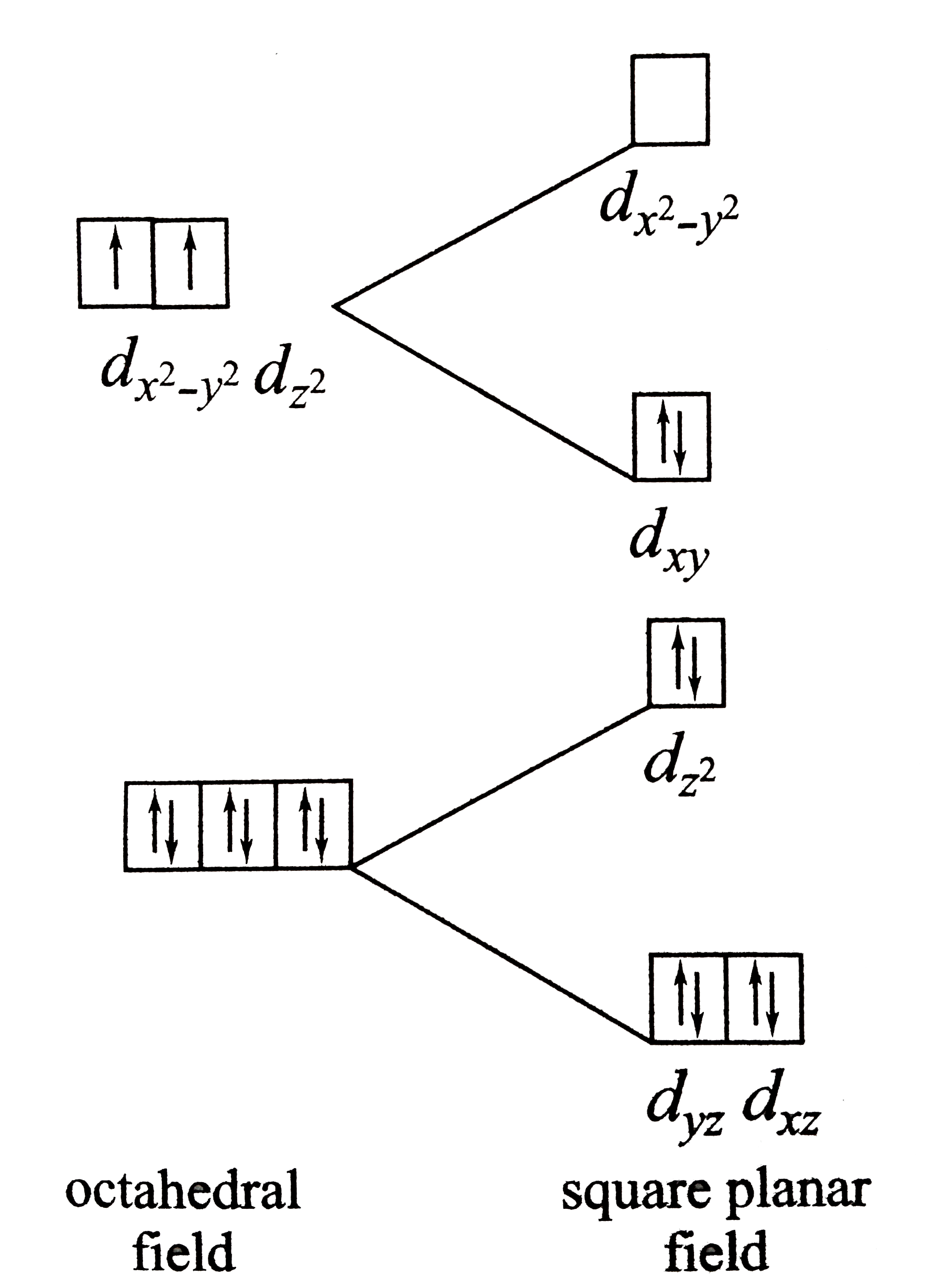Which of the following d-electron distribution of the diamagnetic complex [Ni(CN)]2− is possible according to the crystal field theory ?
A
(dyz)2(dxy)2(dz2)2(dxy)2
B
(dxy)2(dxz)2(dyz)2(dx2−y2)1(dz2)1
C
(dxy)2(dxy)2(dyz)2(dx2−y2)2
D
(dxy)2(dxz)2(dyz)2(dz2)2
Video Solution
Text Solution
The correct Answer is:A
For the period 4 transition metals, it is only Ni that tends to form square planer complexes, such as the tetracyanidonikelate (II) ion, [Ni(CN)4]2− . These complexesare diamagnetic. We can develop a crystal field diagram to see why this is so, even though both octahedral and tetrahedral geometries result in two unpaired electrons for the d8 configuration. If we start form the octahedral field withdrawn the ligands form the z-axis, the d2z orbital will no longer g=feel the electrostatic repulsion form axial ligands, hence, it will drop substantially in energy. The other two orbitals with a-z axis component (the dxz and dyz) will also undergo a decrease in energy. Conversely, with the withdrawl of the aial ligands, there will be a greater electrostatic attraction on the ligands in the plane and these will become closer to the metal ion. As a result, the dx2−y2 and dz2 orbitals will increase substantially in energy.

As the Ni2+ complex with CN− ligands is diamagnetic, the splitting of the dx2−y2 and the dxy orbitals must be greater than the pairing for this combination. In the square planar case, only low spin complexes have been found.
|
Updated on:21/07/2023
Topper's Solved these Questions
- BOOK - R SHARMACHAPTER - COORDINATION COMPOUNDSEXERCISE - Question Bank (Building the knowledge)38videos
COORDINATION COMPOUNDS
- BOOK - R SHARMACHAPTER - COORDINATION COMPOUNDSEXERCISE - Archives56videos
COORDINATION COMPOUNDS
- BOOK - R SHARMACHAPTER - CHEMISTRY IN EVERYDAY LIFEEXERCISE - Archives11videos
CHEMISTRY IN EVERYDAY LIFE
- BOOK - R SHARMACHAPTER - ELECTROCHEMISTRYEXERCISE - Follow-up Test 117videos
ELECTROCHEMISTRY
Similar Questions
Knowledge Check
- Question 1 - Select One
According to crystal field theory (CFT) :
Aorder of increasing field strength of ligands is : F−>H2O>NH3BIf pairing energy exceeds the magnitude of crystal field splitting then pairing occursCd4 to d7 co-ordination entities are more stable for strong field as compared to weak field casesDTetrahedral complexes have sufficiently large splitting energy to force pairing and therefore, high spin configuration are rarely observed. - Question 2 - Select One
According to crystal field theory (CFT) :
Aorder of increasing field strength of ligands is : F−>H2O>NH3BIf pairing energy exceeds the magnitude of crystal field splitting then pairing occursCd4 to d7 co-ordination entities are more stable for strong field as compared to weak field casesDTetrahedral complexes have sufficiently large splitting energy to force pairing and therefore, high spin configuration are rarely observed. - Question 3 - Select One
Which of the following complex is diamagnetic ?
A[Co(CN)6]3−B[Mn(H2O)6]2+C[Fe(_(2)O)6]2+D[Fe(H2O)6]3+
Which of the following complexes is diamagnetic ?
View SolutionWhich of the following is diamagnetic complex
View SolutionWhich of the following is a diamagnetic complex
View SolutionWhich of the following paramagnetic complex with two unpaired electrons in t2g orbital according to crystal field theory
View SolutionWhich of the following energy shows the electron distribution according to the crystal field model of the 3d-electrons in CoCl2−4
View Solution

